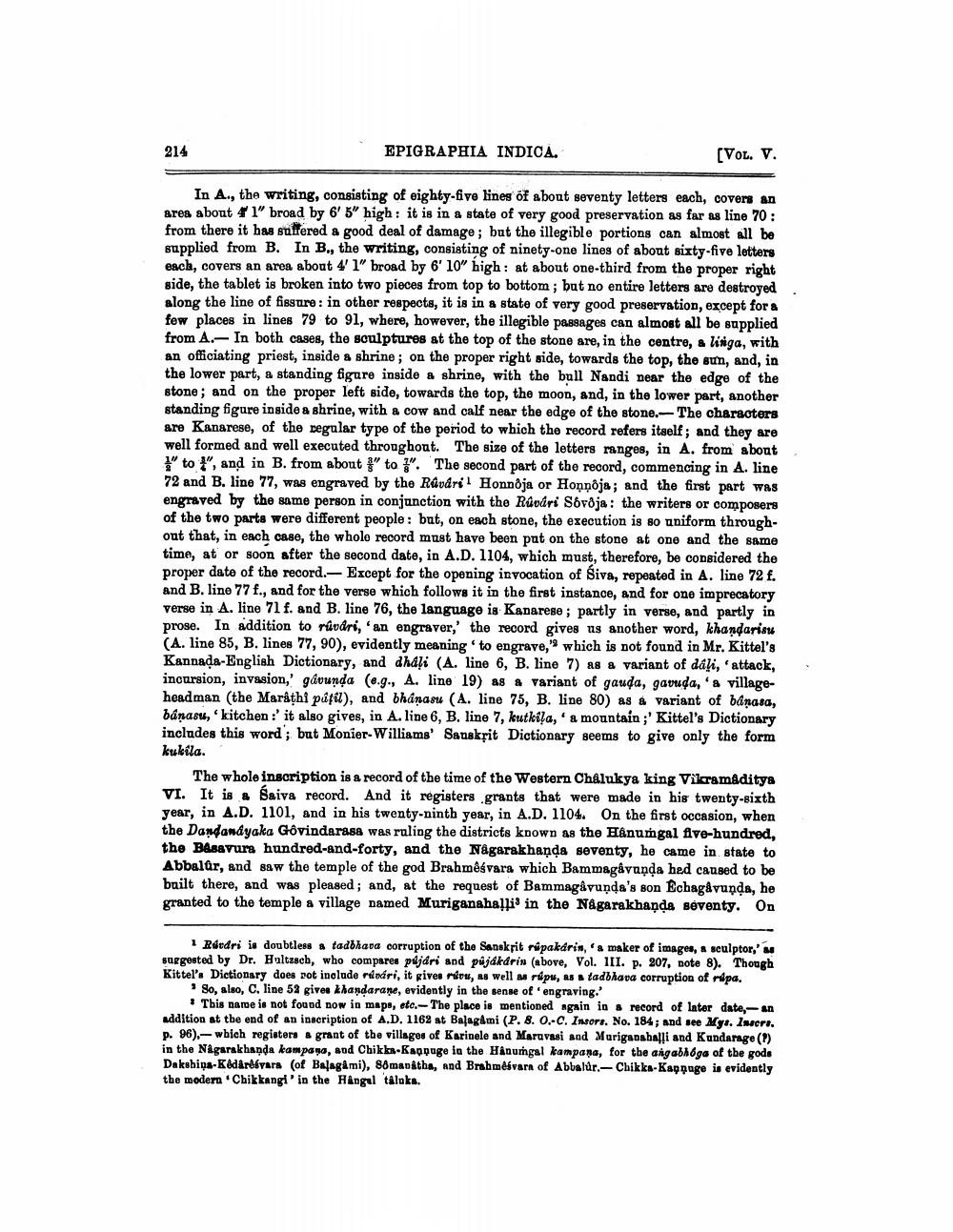________________
214
EPIGRAPHIA INDICA.
[Vol. V.
In A., the writing, consisting of eighty-five lines of about seventy letters each, covers an area about 1" broad by 6'5" high: it is in a state of very good preservation as far as line 70 : from there it has suffered a good deal of damage ; but the illegible portions can almost all be supplied from B. In B., the writing, consisting of ninety-one lines of about sixty-five letters each, covers an area about 4' 1" broad by 6' 10" high: at about one-third from the proper right side, the tablet is broken into two pieces from top to bottom; but no entire letters are destroyed along the line of fissure : in other respects, it is in a state of very good preservation, except for a few places in lines 79 to 91, where, however, the illegible passages can almost all be supplied from A.-In both cases, the sculptures at the top of the stone are, in the centre, a linga, with an officiating priest, inside a shrine ; on the proper right side, towards the top, the sun, and, in the lower part, a standing figure inside & shrine, with the bull Nandi near the edge of the stone; and on the proper left side, towards the top, the moon, and, in the lower part, another standing figure inside a shrine, with a cow and calf near the edge of the stone.-The characters are Kanarese, of the regular type of the period to which the record refers itself; and they are well formed and well executed throughout. The size of the letters ranges, in A. from about
" to +", and in B. from about " to 3". The second part of the record, commencing in A. line 72 and B. line 77, was engraved by the Ravdri Honnôja or Honnoja; and the first part was engraved by the same person in conjunction with the Rdvdri Sovja: the writers or composers of the two parts were different people: bat, on each stone, the execution is so uniform throughout that, in each case, the whole record must have been put on the stone at one and the same time, at or soon after the second date, in A.D. 1104, which must, therefore, be considered the proper date of the record. Except for the opening invocation of Siva, repeated in A. line 72 f. and B. line 77 f., and for the verse which follows it in the first instance, and for one imprecatory verse in A. line 71 f. and B. line 76, the language is Kanarese ; partly in verse, and partly in prose. In addition to rúvdri, an engraver,' the record gives us another word, khandaris (A. line 85, B. lines 77, 90), evidently meaning to engrave," which is not found in Mr. Kittel's Kannada-English Dictionary, and dhuļi (A. line 6, B. line 7) as a variant of dali, 'attack, incursion, invasion, gávunda (e.g., A. line 19) a8 & variant of gauda, gavuda, & villageheadman (the Marathi pátu), and thanasu (A. line 75, B. line 80) as & variant of bánasa, bánass, 'kitchen :' it also gives, in A. line 6, B. line 7, kutkila, 'a mountain ;' Kittel's Dictionary includes this word; but Monier-Williams' Sanskrit Dictionary seems to give only the form kulila.
The whole inscription is a record of the time of the Western Chalukya king Vikramaditya VI. It is a Saiva record. And it registers grants that were made in his twenty-sixth year, in A.D. 1101, and in his twenty-ninth year, in A.D. 1104. On the first occasion, when the Dandanayaka Govindarasa was ruling the districts known as the Hânumgal five-hundred, the Basavura hundred-and-forty, and the Någarakhanda seventy, he came in state to Abbalúr, and saw the temple of the god Brahmêśvara which Bammagåvanda hed caused to be built there, and was pleased; and, at the request of Bammagåvunda's son Echagávunda, he granted to the temple a village named Muriganahallis in the Någarakhands seventy. On
1 Rørdri in doubtless & tadbhava corruption of the Sanskrit rapakdrin, 'a maker of images, & sculptor,' suggested by Dr. Haltzsch, who compares pújdri and půjákdris (above, Vol. III. p. 207, note 8). Though Kittel's Dictionary does not include rilaári, it gives rivu, as well as rápu, as a tadbhava corruption of ripa.
So, also, C. line 52 gives khandarane, evidently in the sense of 'engraving.
This name is not found now in maps, etc. The place is mentioned again in a record of later date, an addition at the end of an inscription of A.D. 1162 at Balagami (P. 8. 0.-C. Insors. No. 184; and see Mys. Insers. p. 96), - which registers & grant of the villages of Karinele and Maruvasi and Moriganahalli and Kundarage () in the Någarakhanda kampage, and Chikka-Kappuge in the Hinungal kampaşa, for the angabloga of the gods Daksbiga-Kâdártávars (of Balagâmi), Sómanátha, and Brabmèsvara of Abbalur.- Chikka-Kaqnage is evidently the modern 'Chikkangi' in the Hangal táloks.




